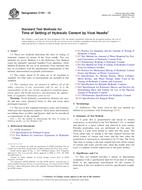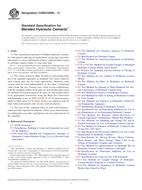We need your consent to use the individual data so that you can see information about your interests, among other things. Click "OK" to give your consent.
ASTM C191-13
Standard Test Methods for Time of Setting of Hydraulic Cement by Vicat Needle
STANDARD published on 1.12.2013
The information about the standard:
Designation standards: ASTM C191-13
Note: WITHDRAWN
Publication date standards: 1.12.2013
SKU: NS-12475
The number of pages: 8
Approximate weight : 24 g (0.05 lbs)
Country: American technical standard
Category: Technical standards ASTM
The category - similar standards:
Annotation of standard text ASTM C191-13 :
Keywords:
automatic vicat, hydraulic-cement paste, time of setting, vicat, vicat needle, ICS Number Code 91.100.10 (Cement. Gypsum. Lime. Mortar)
Additional information
| Significance and Use | ||||||||||||||||||||||||
|
5.1 This test method provides a means of determining compliance with a specification limit for Vicat time of setting. Refer to the appropriate specification for the cement to determine if this test method is used for specification compliance. 5.2 Time of setting measured by this method will not necessarily provide the same results as the time of setting of hydraulic cement paste measured by other methods, or the time of setting of mortar or concrete. |
||||||||||||||||||||||||
| 1. Scope | ||||||||||||||||||||||||
|
1.1 These test methods determine the time of setting of hydraulic cement by means of the Vicat needle. Two test methods are given; Method A is the Reference Test Method using the manually operated standard Vicat apparatus, while Method B permits the use of an automatic Vicat machine that has, in accordance with the qualification requirements of this method, demonstrated acceptable performance. 1.2 The values stated in SI units are to be regarded as standard. No other units of measurement are included in this standard. 1.3 This standard does not purport to address all of the safety concerns, if any, associated with its use. It is the responsibility of the user of this standard to establish appropriate safety and health practices and determine the applicability of regulatory limitations prior to use. Warning: Fresh hydraulic cementitious mixtures are caustic and may cause chemical burns to skin and tissue upon prolonged exposure.2 1.4 The text of this standard references notes and footnotes which provide explanatory material. These notes and footnotes (excluding those in tables and figures) shall not be considered as requirements of the standard.
|
|
Standard Specification for Reference Masses and Devices for Determining Mass and Volume for Use in Physical Testing of Hydraulic Cements
|
|
Standard Performance Specification for Hydraulic Cement
|
|
Standard Specification for Reagent Water
|
|
Standard Practice for Sampling and the Amount of Testing of Hydraulic Cement
|
|
Standard Test Method for Amount of Water Required for Normal Consistency of Hydraulic Cement Paste
|
|
Standard Test Method for Autoclave Expansion of Hydraulic Cement
|
|
Standard Test Method for Time of Setting of Hydraulic-Cement Paste by Gillmore Needles
|
|
Standard Practice for Mechanical Mixing of Hydraulic Cement Pastes and Mortars of Plastic Consistency
|
|
Standard Specification for Mixing Rooms, Moist Cabinets, Moist Rooms, and Water Storage Tanks Used in the Testing of Hydraulic Cements and Concretes
|
|
Standard Specification for Blended Hydraulic Cements
|
|
Standard Specification for Portland Cement
|
|
Standard Terminology Relating to Hydraulic and Other Inorganic Cements (Includes all amendments and changes 8/28/2020). |
Similar standards:
Historical
1.8.2012
Historical
1.1.2013
Historical
1.8.2012
Historical
1.8.2012
Historical
1.4.2014
Historical
1.5.2014
We recommend:
Updating of laws
Do you want to be sure about the validity of used regulations?
We offer you a solution so that you could use valid and updated legislative regulations.
Would you like to get more information? Look at this page.



 ASTM C531-00(2012)..
ASTM C531-00(2012).. ASTM C563-13
ASTM C563-13 ASTM C579-01(2012)..
ASTM C579-01(2012).. ASTM C580-02(2012)..
ASTM C580-02(2012).. ASTM C587-04(2014)..
ASTM C587-04(2014).. ASTM C595/C595M-14..
ASTM C595/C595M-14..
 Cookies
Cookies
